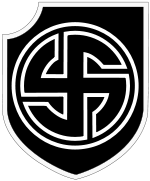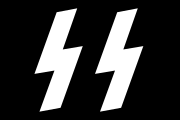11th SS Volunteer Panzergrenadier Division Nordland
| 11th SS Volunteer Panzergrenadier Division Nordland | |
|---|---|
|
Divisional insignia | |
| Active | July 1943 – May 1945 |
| Country |
|
| Branch |
|
| Type | Panzergrenadier |
| Size | Division |
| Engagements |
Battle of Narva (1944) Battle of Tannenberg Line Battle of Berlin |
| Commanders | |
| Notable commanders |
Franz Augsberger Fritz von Scholz |
The 11th SS Volunteer Panzergrenadier Division Nordland was a Waffen-SS division recruited from foreign populations. It saw action in the Independent State of Croatia and on the Eastern Front during World War II.
Formation
In February 1943, Hitler ordered the creation of an SS division which would be officered by foreign volunteers. In March 1943, the Wiking's SS-Panzergrenadier-Regiment Nordland, a Scandinavian volunteer regiment, was separated from the Wiking Division and pulled out of the line to be used as the nucleus for the new division.[1] The Nordland's two Panzergrenadier regiments were also given titles that referenced the location where the majority of the regiment's recruits were from, SS-Panzergrenadier Regiment 23 Norge (Norway) and SS-Panzergrenadier Regiment 24 Danmark (Denmark). Both regiments had addition men made up of conscripts from Hungary.[2]
After its formation in Germany, the division was attached to the III (Germanic) SS Panzer Corps under the command of Obergruppenführer Felix Steiner and was moved to Croatia, where the SS Volunteer Legion Netherlands was attached to it. The division began combat operations against Yugoslav partisans in September 1943.[3]
1944–1945
Nordland, along with the rest of III. (Germanic) SS Panzer Corps arrived at the front near Leningrad and was put into action against the Red Army attacks aimed at breaking the German encirclement of the city.[4] The Red Army forced the Nordland to withdraw to Oranienbaum. On 14 January 1944, the Soviet Krasnoye Selo–Ropsha Offensive succeeded in collapsing the German front, forcing the Nordland to retreat and fight "rear-guard" actions back to the city of Narva in northeastern Estonia to a new defensive line.[5]
From 27 July 1944, Nordland fought alongside the 20th SS Grenadier Division (1st Estonian) and elements of the Grossdeutschland Division In the Battle of Tannenberg Line. During these battles the commanders of the Norge and Danmark regiments were killed in action. While visiting the front line, Nordland Division's commander, Gruppenführer Fritz von Scholz was caught in an artillery barrage and received a head wound. Scholz died on 28 July 1944. Thereafter, Brigadeführer Joachim Ziegler took over command of the Nordland Division.[6] It retreated into what was known as the Courland Pocket. From late October to December 1944, the Nordland remained in the pocket; by early December the divisional strength was down to 9,000 men. In January 1945, the division was ordered to the Baltic port of Libau, where it was evacuated by sea.[7]
Battle of Berlin
On 16 April, Nordland was ordered back into the line east of Berlin. Despite recent replenishment, the division was still grossly understrength. From 17 to 20 April, the division was involved in combat all along its front, and withdrew into the city. On 24 April, the main Soviet assault was towards the Treptow Park area, which the rest of the Pioneer battalion and the remaining Tiger tanks of Panzer battalion Hermann von Salza were defending. Obersturmbannführer Kausch led the few tanks and armoured vehicles in a counterattack and succeeded in temporarily halting the enemy advance. However, by midday, the 5th Shock Army was able to advance again.[8] A later counter-attack by three assault guns was stopped by a Soviet soldier named Shulzhenok with three captured German Panzerfausts.[9]
Later in the evening of 24 April between 320 to 330 French troops from the 33rd Waffen-Grenadier Division of the SS Charlemagne arrived in Berlin after a long detour to avoid Soviet advance columns.[10] On 25 April, Brigadeführer Gustav Krukenberg was appointed the commander of (Berlin) Defence Sector C which included the Nordland Division. Joachim Ziegler was relieved of his command of Nordland earlier the same day. The French Waffen-SS troops now known as Sturmbataillon "Charlemagne" was attached to the Nordland Division. The arrival of the French bolstered the Nordland Division whose "Norge" and "Danmark" Panzergrenadier regiments had been decimated in the fighting against the Soviet Red Army forces. They each roughly equalled a battalion.[11]
By 26 April, with Neukölln heavily penetrated by Soviet combat groups, Krukenberg prepared fallback positions for Sector C troops around Hermannplatz. He moved his headquarters into the opera house. As the Nordland division fell back towards Hermannplatz the Charlemagne and one-hundred Hitler Youth attached to their group destroyed 14 Soviet tanks with Panzerfausts; one machine gun position by the Halensee bridge managed to hold up any Soviet advance in that area for 48 hours.[12] The Nordland's remaining armour, eight Tiger tanks and several assault guns, were ordered to take up positions in the Tiergarten, because although the two divisions of Weidling's LVI Panzer Corps could slow the Soviet advance down, they could not stop it.[13]
The Soviet forces advance into Berlin followed a pattern of massive shelling followed by assaults using house-clearing battle groups of about 80 men in each, with tank escorts and close artillery support. On 27 April, the remnants of Nordland were pushed back into the central government district (Zitadelle sector) in Defence sector Z. Krukenberg's Nordland headquarters was a carriage in the Stadtmitte U-Bahn station.[14] Thereafter, the troops in the government district were pushed back into the Reichstag and Reich Chancellery.[15][16]
On 30 April, after receiving news of Hitler's suicide, orders were issued that those who could do so were to break out. Prior to that Brigadeführer Wilhelm Mohnke briefed all commanders that could be reached within the Zitadelle sector about the events as to Hitler's death and the planned breakout.[17] The break out from the Reich Chancellery and Führerbunker started at 2300 hours on 1 May. There were ten main groups that attempted to head northwest.[18]
Fierce fighting continued all around, especially in the Weidendammer Bridge area. What was left of the Nordland Division under Krukenberg fought hard in that area but Soviet artillery and anti-tank guns were too strong. The Nordland's last Tiger was knocked out attempting to cross the Weidendammer Bridge.[19] Thereafter, several small groups reached the Americans at the Elbe's west bank, but most (including Mohnke's group and men from Krukenberg's group), did not break out.[17] Krukenberg made it to Dahlem, where he hid out in an apartment for a week but then had to surrender.[20]
On 2 May hostilities officially ended by order of Helmuth Weidling, Kommandant of the Defence Area Berlin and General of Artillery.[21]
Commanders
- SS-Brigadeführer Franz Augsberger (22 March 1943 – 1 May 1943)
- SS-Gruppenführer Fritz von Scholz (1 May 1943 – 27 July 1944)
- SS-Brigadeführer Joachim Ziegler (27 July 1944 – 25 April 1945)
- SS-Brigadeführer Gustav Krukenberg (25 April 1945 – 8 May 1945)
See also
- Waffen-SS foreign volunteers and conscripts
- List of Knight's Cross Recipients 11th SS Volunteer Panzer Grenadier Division Norland
References
Citations
- ↑ Littlejohn (1987) p. 52.
- ↑ Littlejohn (1987) p. 54.
- ↑ Littlejohn (1987) p. 54.
- ↑ Littlejohn (1987) p. 54.
- ↑ Littlejohn (1987) p. 54.
- ↑ Ailsby (1997) p. 186.
- ↑ Littlejohn (1987) p. 54.
- ↑ Beevor (2002) p. 297.
- ↑ Beevor (2002) p. 301.
- ↑ Forbes (2010) [2006] pp. 396-398.
- ↑ Beevor (2002) pp 301, 302.
- ↑ Beevor (2002) p. 303.
- ↑ Beevor (2002) p. 319.
- ↑ Beevor (2002) p. 323.
- ↑ Forbes (2010) [2006] p. 425.
- ↑ Beevor (2002) pp. 321, 323, 351-352.
- 1 2 Fischer (2008), p. 49.
- ↑ Beevor (2002) p. 382.
- ↑ Beevor (2002) p. 382, 383.
- ↑ Beevor (2002) p. 384.
- ↑ Fischer (2008), pp 49–50.
Bibliography
- Ailsby, Christopher (1997). SS: Roll of Infamy. Motorbooks Intl. ISBN 0760304092.
- Beevor, Antony (2002). Berlin – The Downfall 1945. Viking-Penguin Books. ISBN 978-0670030415.
- Fischer, Thomas (2008). Soldiers of the Leibstandarte. J.J. Fedorowicz Publishing, Inc. ISBN 978-0921991915.
- Forbes, Robert (2010) [2006]. For Europe: The French Volunteers of the Waffen-SS. Stackpole Books. ISBN 978-0-8117-3581-0.
- Hillblad, Thorolf – Twilight of the Gods: A Swedish Waffen-SS Volunteer's Experiences with the 11th SS-Panzergrenadier Division Nordland, Eastern Front 1944–45
- Littlejohn, David (1987). Foreign Legions of the Third Reich Vol. 1 Norway, Denmark, France. Bender Publishing. ISBN 978-0912138176.

